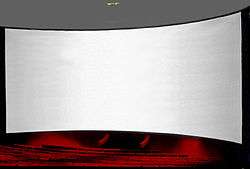Curved screen
Curved screen TVs were introduced to the consumer market in 2013, primarily due to the efforts of Korean companies Samsung and LG[1][2], while curved screen projection displays, such as Cinerama, have been around since the 1950s.[3][4]
Analysis
Curved screens are marketed as providing an "immersive" experience, and allowing a wider field of view.[5] [6] [7] [8]
Similar to a movie theater having good and bad seats, there is an optimal position when it comes to watching TV at home. This optimal position is directly along the central axis of the TV with the central point of the screen at eye level. Viewers seated in any other position come to experience degradations in picture quality ranging anywhere from minor to severe, the most notable being trapezoidal distortion.[9]
Manufacturers suggest that curved screens allow greater range in satisfactory viewing angles and offer minimal trapezoidal distortion compared to flat-screens. The claim that curved screens provide a wider field view is disputed, by another claim that a substantial offset from the center provides greater viewing distortion than that of a flat screen.[10] However, the equidistant claim by manufacturers of the various parts of the screen from a centered view is supported.[10]
Curved TVs supposedly offer minimized glare from ambient light.[9]
Applications
To reduce outer edge distortions and provide a panoramic view, large curved screens accomplish this free of bezel lines framing each screen, and the alternative was to use multiple flat-screen monitors around the viewer. Curved screens and multi-screens have applications in gaming.
Backward curved screens have the potential to be used as digital signage that can be installed at various locations to produce marketing exposure.
Projection screens
When projecting images onto a completely flat screen, the distance light has to travel from its point of origin (i.e., the projector) increases the farther away the destination point is from the screen's center. This variance in the distance traveled results in a distortion phenomenon known as the pincushion effect, where the image at the left and right edges of the screen becomes bowed inwards and stretched vertically, making the entire image appear blurry.[9]
Curved screens are also widely used in IMAX and standard movie theaters for their ability to produce natural expressions and draw the audience deeper into the scene. A standard IMAX screen is 22m wide and 16m tall, but there are screens with even larger dimensions. IMAX is the most successful large-format, specialized cinematic-film system.
Touch on curved screen
One of the issues in the use of the curved screen in commercial electronics is how accurately it can work with a touch-sensor. To drive the solution, LG electronics has developed Infrared-based touch solutions for the curved display.[11]
History
The world's first curved screen was the Cinerama, which debuted in New York in 1952. Countless theaters, including the Cinerama Dome in Hollywood began to use horizontally curved screens to counter image distortions associated with super-wide formats such as 23:9 CinemaScope.

21:9 aspect ratio monitors were developed to display the maximum amount of information on a single screen, but the extreme wideness of the screen created severe distortions on the left and right edges of the screen. Curved 21:9 monitors were then developed to address this issue and provide a distortion-free, wide-angle viewing environment.
Manufacturing process
The first curved panels were produced by bending flat panels that had already been manufactured. This technique resulted in performance issues, such as oval mura (a clouding effect) and color mixture (which causes color impurity and image distortion) observed at its curved edges. Since the introduction of flexible glass, liquid crystal displays (LCDs) can be applied to curved surfaces without bending existing panels. The screen technologies used to create curved LCD screens are Vertical Alignment, which helps to reduce any white glow that may affect an angular view, and IPS Panels, which are more susceptible to distortion.[12]
References
- "LG to start selling curved OLED TVs in South Korea". BBC News. 30 April 2019.
- Curtis, Sophie. "LG and Samsung jostle for first place in 105-inch curved tv race". The Telegraph. Retrieved 30 April 2019.
- Kenigsberg, Ben. "Long Before Imax, the Curious Tale of Cinerama". The New York Times. Retrieved 30 April 2019.
- Handy, Bruce. "This is Cinerama". Vanity Fair. Retrieved 30 April 2019.
- Gibbs, Samuel. "Are curved screens just a marketing gimmick?". The Guardian. Retrieved 2 May 2019.
- Wood, Molly. "Grading the Curve in Consumer Electronics". The New York Times. Retrieved 2 May 2019.
- Kelion, Leo. "Curved screen Predator laptop unveiled by Acer at lfa". BBC News. Retrieved 2 May 2019.
- Wood, Molly. "Curved Screens: Worth It?". The New York Times. Retrieved 2 May 2019.
- Andrew Tarantola (January 23, 2014). "Why curved TVs Aren't Just Another Gimmick". Gizmodo.
- Johnston, Casey (January 12, 2014), The flat-out truth on curved TVs, Ars Technica
- Cho, Youngjun (2015). "US patent: DISPLAY APPARATUS AND METHOD FOR OPERATING THE SAME".
- "Deep Dive into Curved Displays". Samsung Display. Retrieved 6 May 2019.